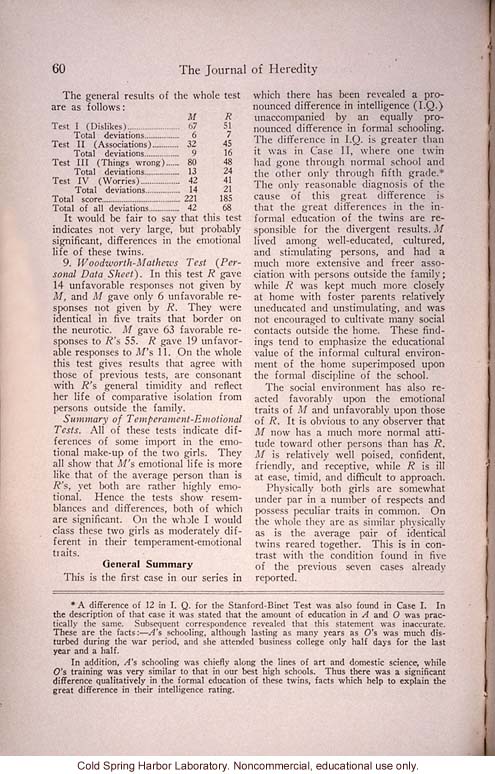60 The Journal of Heredity
The general results of the whole test are as follows:
& & M & R
Test I (Dislikes) . . . & 67 & 51
Total deviations . . . & 6 & 7
Test II (Associations) . . . & 32 & 45
Total deviations . . . & 9 & 16
Test III (Things wrong) . . . & 80 & 48
Total deviations . . . 13 & 24
Test IV . . . & 42 & 41
Total deviations . . . & 14 & 21
Total score . . . & 221 & 185
Total of all deviations . . . & 42 & 68
It would be fair to say that this test indicates not very large, but probably significant, differences in the emotional life of these twins.
9. Woodworth-Mathews Test (Personal Data Sheet). In this test R gave 14 unfavorable responses not given by M, and M gave only 6 unfavorable responses not given by R. They were identical in five traits that border on the neurotic. M gave 63 favorable responses to R's 55. R gave 19 unfavorable responses to M's 11. On the whole this test gives results that agree with those of previous tests, are consonant with R's general timidity and reflect her life of comparative isolation from persons outside the family.
Summary of Temperament-Emotional Tests. All of these tests indicate differences of some import in the emotional make-up of the two girls. They all show that M's emotional life is more like that of the average person than is R's, yet both are rather highly emotional. Hence the test show resemblances and differences, both of which are significant. On the whole I would class these two girls as moderately different in their temperament-emotional traits.
General Summary
This is the first case in our series in which there has been revealed a pronounced difference in intelligence (I.Q.) unaccompanied by an equally pronounced difference in formal schooling. The difference in I.Q. is greater than it was in Case II, where one twin had gone through normal school and the other only through the fifth grade.* The only reasonable diagnosis of the cause of this great difference is that the great differences in the informal education of the twins are responsible for the divergent results. M lived among well-educated, cultured, and stimulating persons, and had a much more extensive and freer association with persons outside the family; while R was kept much more closely at home with foster parents relatively uneducated and unstimulating, and was not encouraged to cultivate many social contacts outside the home. These findings tend to emphasize the educational value of the informal cultural environment of the home superimposed upon the formal discipline of the school.
The social environment has also reacted favorably upon the emotional traits of M and unfavorably upon those of R. It is obvious to any observer that M now has a much more normal attitude toward other persons than has R. M is relatively well poised, confident, friendly, and receptive, while R is ill at ease, timid, and difficult to approach.
Physically both girls are somewhat under par in a number of respects and possess peculiar traits in common. On the whole they are as similar physically as is the average pair of identical twins reared together. This is in contrast with the condition found in five of the previous seven cases already reported.
[double hairline score page width]
*A difference of 12 in I. Q. for the Stanford-Binet Test was also found in Case I. In the description of that case it was stated that the amount of education in A and O was practically the same. Subsequent correspondence revealed that this statement was inaccurate. These are the facts: -- A's schooling, although lasting as many years as O's was much disturbed during the war period, and she attended business college only half days for the last year and a half.
In addition, A's schooling was chiefly along the lines of art and domestic science, while O's training was very similar to that in our best high schools. Thus there was a significant difference qualitatively in the formal education of these twins, facts which help to explain the great difference in their intelligence rating.
[end]


